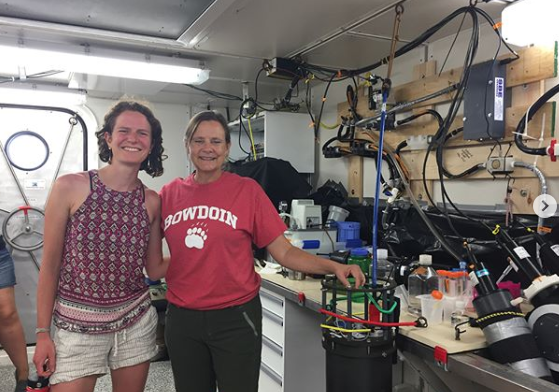Bowdoin’s Collin Roesler Starts Mission to Explore Carbon’s Fate in the Ocean

Bowdoin oceanographer on Aug. 9 Collin Roesler joined a team of more than 100 scientists and crew, from nearly 30 research institutions, to embark on a five-week investigation into the fate of carbon in the ocean.
The team set sail on two research vessels from Seattle, headed to a remote spot 200 miles away in the northeastern Pacific Ocean. At this site, they will study “the secret lives” of phytoplankton and the animals that eat them, according to NASA.
Phytoplankton are microscopic organisms that live at the top of the ocean and play a key role in Earth’s climate by removing heat-trapping carbon dioxide from the atmosphere.
The two ships from @Scripps_Ocean are both named for scientists – the R/V Roger Revelle and the R/V Sally Ride (one of our @NASA_Astronauts!). The Ride is taking off tonight. Tomorrow morning, the Revelle will follow along on the journey to the twilight zone. pic.twitter.com/wvlkXeO2s4
— NASA Earth (@NASAEarth) August 9, 2018
While scientists understand how phytoplankton absorbs carbon dioxide through photosynthesis, they know less about what happens to that carbon after the plankton die and sink to the ocean bottom or are eaten by fish and other organisms.
NASA and the National Science Foundation are funding the thirty-seven day expedition, called the Export Processes in the Ocean from Remote Sensing (EXPORTS). It is the first multidisciplinary science campaign of its kind to study the pathways, fates and carbon-cycle impacts of microscopic organisms in the ocean. Along with the human team on board, a range of underwater robots will be assisting in the study.
Alongside the human researchers? Robotic explorers! Like these from the Applied Physics Lab at the University of Washington. They’ll travel with the ships, taking measurements at various depths. @FishOceansCAN will help track and collect them. pic.twitter.com/FxEiB90FAT
— NASA Earth (@NASAEarth) August 9, 2018
The challenge that EXPORTS addresses requires a diverse crew with a wide range of knowledge. “I am in awe that we’ve been able to bring together a team of true leaders in their individual fields with the single goal of understanding the interactions among life in the sea and the ocean’s carbon cycle,” said David Siegel, professor of marine science at the University of California, Santa Barbara, and EXPORTS science lead. “The team has an unprecedented diversity of expertise, including physicists, ecologists, geochemists, numerical modelers, and genomics, robotics and remote-sensing scientists.”
Roesler, a professor of earth and oceanographic science, joined the trip to develop a plankton-detection program for a new remote ocean-monitoring system. Read more about her project.
Ultimately the knowledge gained on the expedition should help reveal how much the ocean has been protecting, and might continue to protect, the planet as it warms up. “The ocean has been buffering us for years,” Roesler said. “It has been taking up so much excess carbon dioxide for us, and yet we still keep pumping more into the atmosphere.”
Media submitted by NASA
The material is based upon work supported by NASA under award No. 80NSSC17K0700.